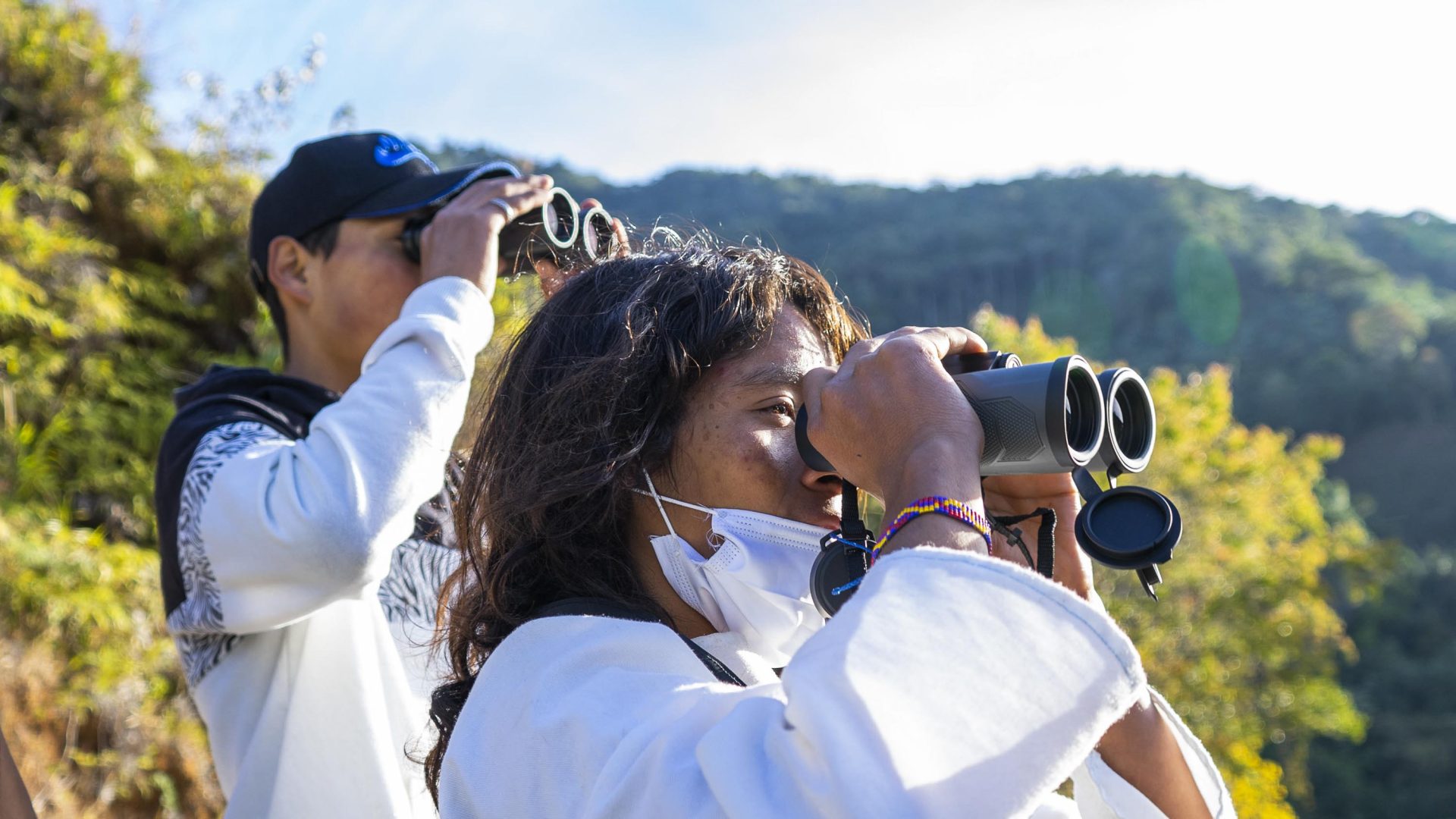
In Colombia’s Sierra Nevada de Santa Marta, writer Chelsea Bengier details how one birdwatching club is preserving the nation’s most sacred region.


In Colombia’s Sierra Nevada de Santa Marta, writer Chelsea Bengier details how one birdwatching club is preserving the nation’s most sacred region.
The sunrise is clear as wisps of mist hug the mountaintops surrounding the village of La Tagua. The sounds of nature come alive in the early light. Birds hang long notes in the crisp air: the trill chirp of the Santa Marta Antbird, the soft drumbeat of a Woodpecker, the ethereal song of the Oriole. It’s a symphony of species that make up one of the Earth’s most irreplaceable ecosystems in the second most biodiverse nation.
Colombia has nearly 2,000 bird species—more than any other country—of which 635 are found just in the Sierra Nevada de Santa Marta, a coastal mountain range older than the Andes. (In comparison, the entire United States has only 800.) The region is home to the largest concentration of endemic birds on the planet. But despite this wealth in wildlife, over a dozen breeds are at risk of global extinction.
In fact, the Sierra Nevada de Santa Marta is in such critical condition it’s been categorized as an Alliance for Zero Extinction site, an Important Bird Area by BirdLife International, and Endemic Bird Area. The habitat is also endangered: 50 years ago cloud forests made up 11 percent of global woodlands. Now? It has plummeted to one percent due to global warming and deforestation.

It’s for this reason that I am here, crouching quietly in the jungle with Spanish biologist and birdwatcher, Dani Couceiro. Four years ago he was drawn to Colombia but quickly realized how its animal populations were declining. Wanting to be a source of change, he applied for a National Geographic grant in 2019 that he used to help fund the Fly High Bird Club.
This program combines science and art to educate children about conservation and local Indigenous communities like the Arhuaco, who consider the Sierra to be the “heart of the world.” Twenty-five teenage students are enrolled in workshops, such as birdwatching, wildlife photography, cosmovision classes, avian muralism, and environmental restoration.
“Tourism is not a joke; it comes with responsibility. This place is going to explode in popularity, and we need to be prepared.”
- Dani Couceiro
“It’s important to nurture the next generation,” Couceiro says. “If you want to have a beautiful life, you must take care of nature. That’s how the idea started: Let’s bring these kids closer to the unique species in their backyard and help them profit from their land in a way that doesn’t require chopping down trees.”
The Sierra Nevada de Santa Marta has seen a huge jump in tourism due to the Lost City trek, Tayrona National Park, and the neighboring town of Minca. For reference, in 2019, Santa Marta airport welcomed 2.4 million passengers; that number is expected to rise to 7.3 million in the near future.
“Tourism is not a joke; it comes with responsibility. This place is going to explode in popularity, and we need to be prepared,” Couceiro says. “One of the problems of tourism coming to this corner of Colombia is that in a lot of cases it does not benefit the local people. Most hospitality businesses are owned by foreigners or nationals from other areas that exclude residents from the decision-making process regarding what happens with their territory. When the first international travelers arrived in La Tagua, we thought about how we could provide the necessary tools to this beautiful remote village in order to avoid that colonialist pattern.”
Birdwatching is a conscientious type of tourism and remains the cornerstone of Couceiro’s club. “We are located in what is considered the ‘Holy Grail’ of birdwatching because of its extremely high levels of endemism,” Couceiro says. “Birds are the door to an ecosystem—through them, you learn a lot about a habitat.” The club’s two-year conservation program is a “pedagogy of place” that aims to empower youth to find sustainable alternatives. His graduates have gone on to become birdwatching guides, wildlife photographers, regenerative farmers and research assistants.
“These mountains call to people who are on emotional, internal journeys and want to do good.”
- Dani Couceiro
The Sierra Nevada de Santa Marta is home to four Indigenous tribes: Kogi, Arhuaco, Wiwa, and Kankuamo—all of whom are actively involved in the club. Fly High works with Wiwa and Kogi youth to integrate their wildlife knowledge into the workshops. In August, Couceiro trained the first generation of Wiwa birdwatching guides. One Kogi student even founded Nuwabirdlife, a successful tour company in the region. This has resulted in a cultural exchange: “I just discovered ethno-ornithology, the study of the relationship between people and birds, including the stories and symbolism behind them,” Couceiro says.
On our walk, Couceiro stops to pin his binoculars on a Squirrel Cuckoo. “It only sings when it is giving a warning, whether that is a dangerous animal below or because it senses negativity or turmoil inside you,” he explains. “It also has different calls if someone is telling you a lie,” according to indigenous beliefs.
On a new 12.5-mile nature trail stretching from the small coffee farming village of La Tagua and the San Lorenzo Ridge to the Wimake pueblo, you can observe around 100 bird species, including the majority of endemics unique to the Sierra Nevada as well as some migratory species. Maps, murals and informational signs about the area’s agriculture, medicinal plants, water sources, birds and frogs are displayed along the route. In September, Couceiro and other volunteers completed a permanent nature photography exhibit, where all the pictures were taken by students. In addition, they’re helping the Indigenous company Wiwa Tours to develop other trail guides around the Sierra Nevada that describe the cultural interpretations of local birds.

Going forward, Fly High will continue improving the area through environmental muralism and new green spaces, such as a Colibrí hummingbird garden. “The goal for the next five years is to expand to more schools,” Couceiro notes. “We ask the kids, ‘What are you proud of in your community? What would you like to show the world? What makes you say, with a big smile, ‘I am from La Tagua!’”
Those traveling to the Sierra Nevada de Santa Marta region of Colombia can take a birdwatching tour with Couceiro through Nuwabirdlife or Trekker Glamping. For avian enthusiasts at home, he recommends Merlin, a free birding app by Cornell. No matter where people are, Coucerio believes the most important thing about reconnecting with our own nature is to get outside and look to the sky.
“These mountains call to people who are on emotional, internal journeys and want to do good,” Coucerio says. “I’m feeding my soul. Birding is as much about listening as it is watching. It takes patience and love. Every day is a different gift.”




Can't find what you're looking for? Try using these tags: